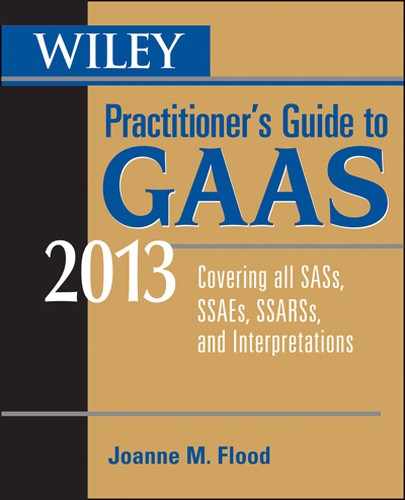AU 544: Lack of Conformity with Generally Accepted Accounting Principles
AU-C 800: Special Considerations—Audits of Financial Statements Prepared in Accordance with Special Purpose Frameworks
AU EFFECTIVE DATE AND APPLICABILITY
| Original Pronouncements | Statement on Auditing Procedure (SAP) 33 (codified in Statement on Auditing Standards [SAS] 1); SAS 2, 62, and 77. |
| Effective Date | These statements currently are effective. |
| Applicability | Audits of financial statements of regulated companies in accordance with generally accepted auditing standards (GAAS) when the financial statements are presented for purposes other than regulatory filings. |
AU-C EFFECTIVE DATE AND SUMMARY OF CHANGES
SAS No. 122, Codification of Auditing Standards and Procedures, is effective for audits of financial statements with periods ending on or after December 15, 2012.
AU Section 334 is focused on auditing the amounts and disclosures pursuant to accounting principles generally accepted in the United States (US GAAP), and it is centered on the provisions of Financial Accounting Standards Board (FASB) Statement No. 57. AU-C 800 is framework neutral, encompassing financial reporting frameworks in addition to US GAAP, such as International Financial Reporting Standards as promulgated by the International Accounting Standards Board.
The objectives, requirements, and definitions in AU-C 800 are applicable irrespective of whether the applicable financial reporting framework establishes requirements for related-party disclosures.
AU DEFINITION OF TERM
Regulated companies. Companies, such as public utilities and insurance companies, whose accounting practices are prescribed by governmental regulatory authorities or commissions.
AU-C DEFINITIONS OF TERMS
Source: AU-C 800.07
Special purpose financial statements. Financial statements prepared in accordance with a special purpose framework.
Special purpose framework. A financial reporting framework other than GAAP that is one of the following bases of accounting:
The cash, tax, and regulatory bases of accounting are commonly referred to as other comprehensive bases of accounting (OCBOA).
OBJECTIVES OF AU SECTION 544
Governmental regulatory authorities or commissions may prescribe accounting practices for regulated companies. Examples of these companies include public utilities, common carriers, insurance companies, and financial institutions. Sometimes the prescribed accounting practices are not in conformity with GAAP. This section tells the auditor the kind of report he or she should issue when a regulated company presents financial statements for purposes other than regulatory filings that follow accounting practices prescribed by regulatory authorities or commissions that are not in conformity with GAAP.
Differences between prescribed accounting practices and accounting practices applicable to nonregulated businesses that are caused by the rate-making process can be in conformity with GAAP. Guidance on accounting for regulated enterprises is contained in several FASB Statements of Financial Accounting Standards, particularly SFAS 71, Accounting for the Effects of Certain Types of Regulation, SFAS 90, Regulated Enterprises—Accounting for Abandonments and Disallowances of Plant Costs, SFAS 92, Regulated Enterprises—Accounting for Phase-in Plans, and SFAS 101, Regulated Enterprises—Accounting for the Discontinuation of Application of FASB Statement 71.
OBJECTIVES OF AU-C SECTION 800
AU-C section 800 states that:
. . . the objective of the auditor, when applying generally accepted auditing standards (GAAS) in an audit of financial statements prepared in accordance with a special-purpose framework, is to address appropriately the special considerations that are relevant to
FUNDAMENTAL REQUIREMENTS
Departures from GAAP
The auditor should express a qualified opinion or an adverse opinion when a regulated company issues financial statements to anyone other than its regulatory agency that are prepared in conformity with accounting practices prescribed by regulatory authorities or commissions that do not conform with GAAP.
Financial Statements Solely for Filing with Regulatory Agency
The auditor may report on a regulated company’s financial statements as being prepared in accordance with a comprehensive basis of accounting other than generally accepted accounting principles (see Section 623, Special Reports) only if the statements are solely for filing with the regulatory agency.
Financial Statements for other than Filing with Regulatory Agency
The auditor may be asked to report on the fair presentation of financial statements in conformity with a regulatory prescribed basis of accounting in presentations other than filings with the regulatory agency. In these circumstances, the auditor’s standard report should be modified because of the departure from GAAP, and, in an additional paragraph, an opinion may be expressed on the conformity of the financial statements with the prescribed method.
INTERPRETATIONS
There are no interpretations for this section.
